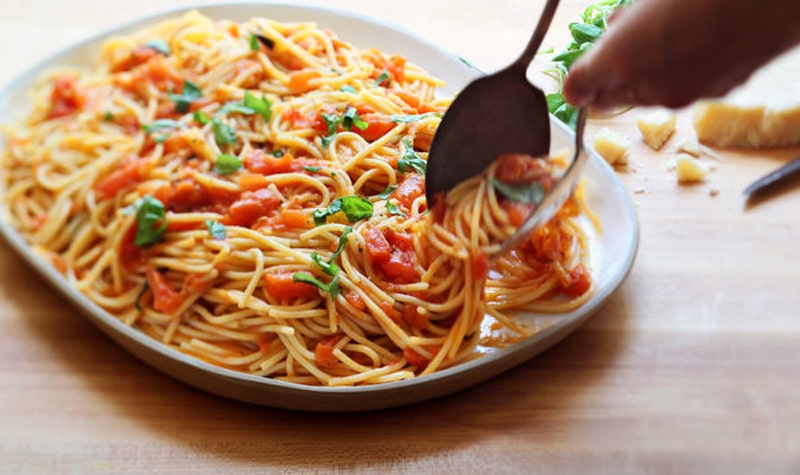Contents
The Significance of Basil in Spaghetti Sauce
Basil is a key ingredient in Italian cuisine and plays a pivotal role in the creation of authentic spaghetti sauce. Its vibrant green leaves possess a sweet and slightly peppery flavor profile that complements the acidity of tomatoes and enhances the overall taste of the sauce. The unique combination of aromatics and oils present in basil infuses the sauce with a delightful fragrance and complexity, making it a staple ingredient in traditional Italian recipes.Health Benefits of Basil
Aside from its culinary value, basil also offers several health benefits. It is a rich source of essential nutrients, including vitamin K, vitamin A, and iron. Basil is known for its anti-inflammatory properties and contains powerful antioxidants that help protect the body against oxidative stress. Additionally, basil has antimicrobial properties, making it a natural remedy for fighting bacteria and promoting overall wellness.Selecting and Storing Fresh Basil
To ensure the best flavor and quality, it’s important to choose fresh basil when preparing spaghetti sauce. Look for vibrant green leaves that are free from blemishes or discoloration. The aroma should be strong and fragrant, indicating freshness. Avoid wilted or yellowing leaves, as they are a sign of deterioration. When storing fresh basil, trim the stems and place the bunch in a glass of water, similar to a bouquet of flowers. Cover the leaves loosely with a plastic bag and store in the refrigerator. Alternatively, you can preserve basil by freezing it. Simply blanch the leaves quickly in boiling water, pat them dry, and place them in a freezer-safe container or bag.Preparing Fresh Basil for Spaghetti Sauce
Before incorporating fresh basil into your spaghetti sauce, it’s essential to prepare it properly. Gently wash the leaves under cold running water to remove any dirt or debris. Once clean, pat them dry with a kitchen towel or use a salad spinner. To intensify the flavor, you can opt to tear the basil leaves into smaller pieces or leave them whole for a more subtle infusion.Authentic Spaghetti Sauce Recipe with Fresh Basil
Now, let’s delve into an authentic spaghetti sauce recipe that highlights the delightful flavors of fresh basil. Here’s what you’ll need: Ingredients:- 1 can (28 ounces) crushed tomatoes
- 1 can (14 ounces) tomato sauce
- 2 tablespoons tomato paste
- 1 small onion, finely chopped
- 2 cloves garlic, minced
- 1 tablespoon olive oil
- 1 teaspoon sugar
- 1 teaspoon dried oregano
- 1 teaspoon dried basil
- Salt and pepper to taste
- Fresh basil leaves, chopped (for garnish)
- In a large saucepan, heat the olive oil over medium heat. Add the chopped onion and minced garlic, and sauté until they become translucent and fragrant.
- Stir in the crushed tomatoes, tomato sauce, and tomato paste. Mix well to combine.
- Add the sugar, dried oregano, dried basil, salt, and pepper. Stir to incorporate the seasonings evenly.
- Reduce the heat to low and let the sauce simmer for at least 30 minutes, allowing the flavors to meld together.
- Just before serving, stir in the fresh basil leaves for an extra burst of flavor and vibrant color.
- Ladle the sauce over cooked spaghetti noodles or your pasta of choice. Garnish with additional fresh basil leaves.
- Enjoy the delicious and authentic taste of spaghetti sauce infused with fresh basil!
Variations and Tips for Using Fresh Basil
Fresh basil can be utilized in various ways to enhance your culinary creations beyond spaghetti sauce. Here are a few ideas to inspire you:- Incorporate fresh basil into homemade pesto sauce for a vibrant and aromatic twist.
- Add chopped basil to Caprese salads, bruschetta, or tomato-mozzarella sandwiches for a burst of freshness.
- Infuse olive oil with basil leaves for a flavorful dressing or marinade.
- Sprinkle torn basil leaves over pizza or flatbreads just before serving.
- Blend basil into smoothies or create refreshing basil-infused lemonade.
Homemade Tomato-Based Spaghetti Sauce
Frequently Asked Questions (FAQs)
Q1: Can I use dried basil instead of fresh basil in spaghetti sauce? Yes, you can substitute dried basil for fresh basil in spaghetti sauce. However, keep in mind that the flavor will be less vibrant, and the aroma may be less pronounced. Use approximately one-third of the amount of dried basil compared to fresh basil called for in the recipe. Q2: How long can I store fresh basil? Fresh basil can be stored in the refrigerator for up to a week when properly stored in a glass of water and covered with a plastic bag. Alternatively, you can freeze basil for several months by blanching the leaves and placing them in a freezer-safe container. Q3: Can I grow basil at home? Yes, basil is relatively easy to grow at home. It thrives in warm climates and requires well-drained soil and plenty of sunlight. Consider starting with a small potted plant or growing basil from seeds for a fresh and abundant supply. Q4: What other herbs work well with basil in spaghetti sauce? Herbs such as oregano, thyme, rosemary, and parsley complement basil in spaghetti sauce, adding layers of flavor and complexity. Experiment with different herb combinations to discover your preferred taste. Q5: Can I use basil stems in my sauce? While basil stems are edible, they tend to have a more intense and slightly bitter flavor. It is best to use the leaves for a milder and more balanced taste in your spaghetti sauce.What Unique Flavors Can I Expect to Find at Specialty Donut Shops?
Specialty donut shops with artistry and flavor offer an array of unique flavors that cater to diverse palates. From floral-infused donuts like lavender or hibiscus to savory options like bacon maple or matcha green tea, these establishments push the boundaries of traditional flavors. Expect the unexpected, with creative inventions and delightful surprises at every bite.











